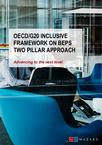
BEPS 2.0 – Advancing to the next level
BEPS 2.0 intends to achieve its objectives by introducing new approaches and to primarily focus on revising existing profit allocation and nexus rules and developing new global minimum tax rules for Multinational enterprises (MNEs) across the globe.
Since the introduction, the Organization for Economic Co-operation and Development (OECD)/G20 Inclusive Framework on BEPS has now advanced to the next level and has formally issued a recent statement to move ahead with the Two-pillar negotiation approach to address the tax challenges of digitalisation. It also reaffirmed the commitment to reach an agreement on a consensus-based solution by end of 2020.
The statement issued by the OECD/G20 Inclusive Framework on BEPS shows the strong and focused approach towards a proper design and effective implementation of the BEPS 2.0 programme across all tax jurisdictions, in both developed and developing countries.
In our detailed brochure, we give an outline of the framework of BEPS 2.0 (including the elements of Pillar One and Pillar Two) and how such may impact MNEs in terms of tax implications for existing group structures and the basis of allocation of taxable profits across the globe. The brochure can be downloaded from the link below:
Our experts


